

 |
 |
Maximum activity of the 2008 Orionid meteor shower peaked on the morning of Oct 21st 2008. This reliable annual meteor shower has been getting more interesting by the year with regular outbursts and high numbers of fireballs. 2008 was expected to be another one of these exceptional years. The Orionids are a particularly attractive shower to watch because the radiant is visible early in the night and stays well placed until dawn. Mid way through the night the radiant, which is located within Orion's club, is quite high on the meridian. These meteors are the dusty debris from Halley's comet. Each year during October the Earth ploughs through this stream of dust which was once, at sometime in the remote past, issuing out from an active dust jet from the comets large icy rotating nucleus. As with any meteor stream, this dust trail is not uniform, but rather filled with swarms of rich material often broken by less dense regions between. When the Earth encounters one of these streams a burst of meteor activity can be seen from the ground. This can be anything between 2 and 5 meteors at any one time during the more exceptional showers. The meteors themselves are bright, of moderate speed, and often leave persistent ion trains. Fireballs are likely also.
So where was I, the showers keen watcher, who had been looking forward to this night for weeks in advance?. I was in bed. Despite feeling shameful I feel I'm a little justified for my lack of dedication this time around. I had spent the previous two days putting in a phenomenal amount of time imaging convective weather events which had been occurring over N. Ireland. Quite frankly, being battered by gales and hail for over 8 hours in a row can really knock the wind from your sails. Combined with my recent unsettled sleep pattern, the days and nights took their tole. On the night of maximum my body had gave up and just wanted to sleep. This lack of sleep was making me shiver in bed, I just couldn't get warm. I went to sleep at 02.30 (all times BST) and set my alarm for 03.30 with the intention of getting up for an intense morning session. The alarm on my mobile phone went off and I awoke. I looked out the window, the sky was stunning and crystal clear! It was a nasty night though, very cold with a bitter NWly wind and the cold moonlight seemed to enhance the bitter night so I decided that I would let it pass and just recover. My instincts told me that if I didn't stay warm and dry for one night then my health would go down hill so I did just that. I always trust my instincts, normally I would think nothing of putting in two sleepless nights to see some night sky action but this time my alarm bells were ringing so I went back to sleep. I recall many years ago undertaking two all night Geminid meteor watches, both nights were windy and absolutely freezing with ice on the ground. By the second night my vision was going and I almost fainted from lack of sleep and warmth. It's humorous now looking back on it, however it was unnerving at the time. I woke again at 07.00 and looked out. It was still clear. The morning twilight arch was well developed, I admired the pre dawn sky for a period. Leo was now well up, Virgo was climbing out from the Sun, Hydra was now much further up since I had seen it last, and Sirius the Dog Star twinkled with it's multicoloured brilliance in the S. I promised myself that tonight I would make more of an effort.
Tuesday Oct 22nd was very unsettled. The sky was 50% clear but there was patchy cloud around. A bone chilling Wly breeze introduced an icy wind chill to the 3 degree C temp. It was not pleasant at all. The sky however was absolutely incredible, easily one of the best nights of the year. The transparency was varying between 8 - 9 out of 10 on my own scale and the seeing was fairly steady. The ground was wet from regular heavy showers of rain and sleet. It was a little early yet to do a watch although the radiant was already at a decent elevation. I decided to warm up inside, have a brew, then I rang astronomer John McConnell for a chat. He reminded me in an excited fashion about how the variable star Chi Cygni was much brighter than expected. He told me he was looking at an image he had just taken showing the star. I walked out my back door and stood in my back yard looking W. Half way up was Cygnus the Swan and below its mid section was Chi. I was both shocked and impressed by how bright this star was. I could see it in an instant with the naked eye despite the glow of street lights and with no dark adaption. This star, which varies in brightness by 10,000 times, looked to be around mag +4.0 so I took a few images for the record. I will be monitoring it closely each night for now on.
John remarked about the high meteor rates from the Orionid shower which he could see from home so I thought that I might as well have a go at a patrol since the sky was getting our attention. During the conversation we observed several faint members so I decided that I would set up the camera for a photographic meteor patrol in the hope of catching an Orionid meteor. I was using a Fujifilm S6500fd 6.3MP bridge camera. Although not a DSLR, it's a great camera. I have found it to be extremely reliable and versatile. With a time exposure of 30 seconds at ISO 800 using the 28mm lens wide open at F/2.8 I began taking images. Often it's very difficult to decide where to point a camera during a meteor shower. Some distance away from the radiant is always a good bet. I have always been a big believer in shooting the N as most showers drop bright members in that sky sector. My N was blocked by houses so I pointed the camera to Andromeda and Pegasus over my own rooftop.
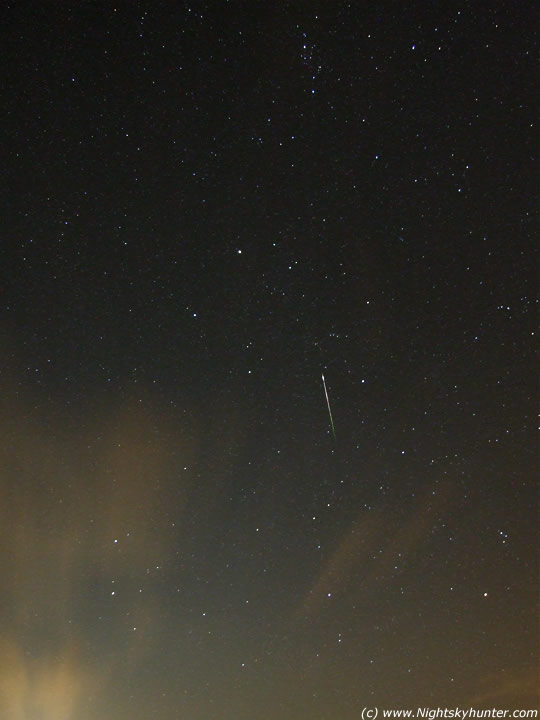 |
01.06. After some time with nothing eventful on show I happened to glance to the NE when I saw a lovely Orionid meteor shoot up from the radiant into Auriga. It was mag +1.0 and left a blue ion train for several seconds. I turned the camera around in that direction, tilted the camera into a vertical position and took an exposure. Wow! an even better Orionid appeared, again in exactly the same place!. This moved upward from the radiant almost vertically and brightening rapidly as it did so. It flared a brilliant white colour at it's peak and burnt up in Auriga leaving a glowing blue-green ion train in its wake for 2 - 3 seconds!. It was gorgeous, and ended up being the best I seen all night. This also is my best meteor image to date. Betelgeuse is the orange star to the lower R. Gemini with Castor and Pollux to the L, and Auriga and Perseus above.
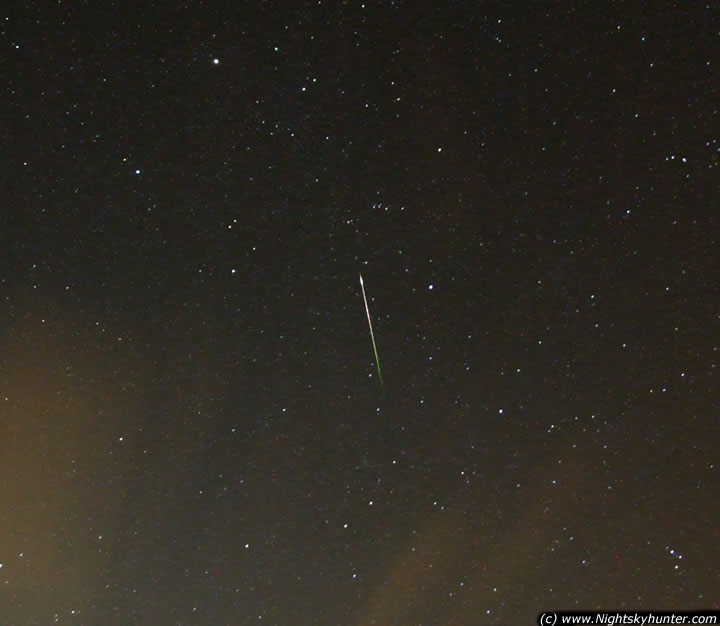 |
This is a crop from the original image. You can see the white, pink, and green colour of the trail. Colours are a visual clue to the composition of the meteor. The bright star at top is Capella. At the bottom of the trail you can see the fuzzy patch of Messier 35 in Gemini. At the top of the trail, and to the L, is Messier 37, 36, and further above, 38. This meteor was very close to the radiant.
At 01.30 I went inside to work on some images for the website. I went back out again for a pre dawn session from 04.30 - 06.25. This time I relocated to a field at a relatively dark location. It was still 50% clear/cloudy. It was very cold but the wind had eased. Patchy cloud drifted over the waning last quarter Moon creating a colourful but brief corona. I did a good dome search then began another patrol. I was worried that the cold temp would drain my batteries before the session ended but they held out to the very end. I couldn't believe the amount of planes arriving in from the W. Their red pulsing lights could be seen from far away over the Sperrins. At one time I seen five in the same constellation. I began taking vertical patrol images of the S where Orion and Canis Major where located. Sirius with the glow from M41 below looked wonderful. After a period of time, during which I took 50 exposures, I turned the camera to other strategic areas.
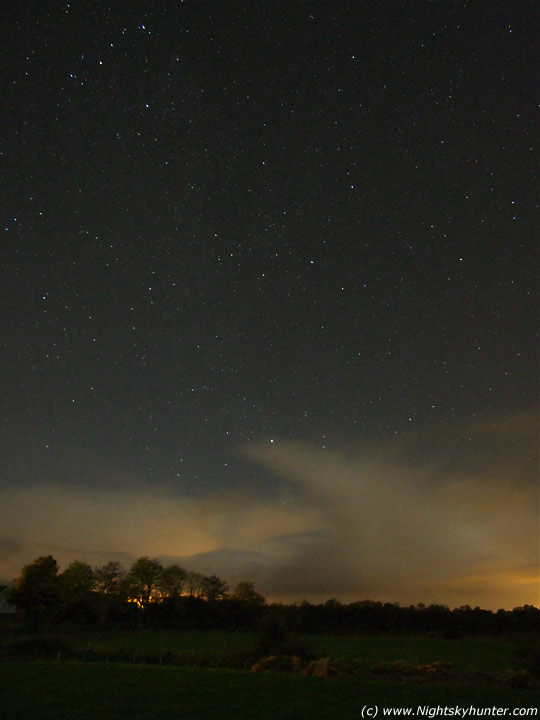 |
05.12. This is looking just E of N. You can just make out the glow of the Milky Way cutting straight up through the image where it meets Cassiopeia. Cepheus is at centre with Lacerta the Lizard to its L. I saved this patrol image because I liked the view. I deliberately framed the clouds with the stars here. Along the northern horizon throughout the entire session where a constant row of convective clouds. Most of them were weak cumulonimbus cells. You can see the wispy anvil on top beside the bright star Deneb. The anvil points straight at this star. The clouds are moving L to R. There's plenty of rain and sleet falling from those. There was some lightning activity in Ireland tonight so I was hoping a bolt would suddenly drop out of those clouds. I was very optimistic, would lightning and a fireball on the same image be too much to ask?. I did try though.
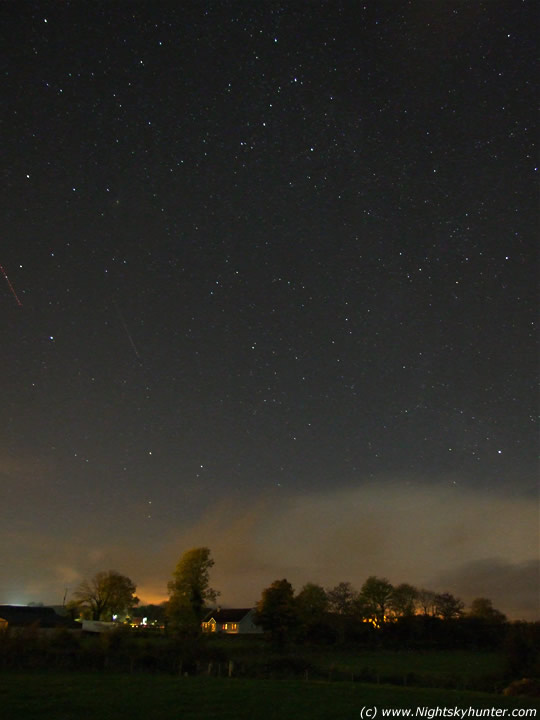 |
05.19. Same location but now the camera is turned more W. I noticed from visual observing that the majority of Orionids where shooting down through the Milky Way in the NW. The vast majority of them where to the W of that milky band so I accommodated the meteors by patrolling in those areas. While the exposure was doing it's thing I was busy jumping up and down on the spot trying to keep warm. I was even shadow boxing to get some circulation back into my arms. Now Lacerta is at centre, the tilted square of Pegasus is to the lower L. Above this is Andromeda with the faint glow of M31. Near the frame is the red trail belonging to one of those planes arriving in from the Atlantic Ocean. To the R of this, and below M31, is another Orionid meteor. This one was mag +4.0. The people in that house had no idea I was standing out here at this time of the morning. You can see the orange glow from the street lights located on the Crewe Road opposite the house.
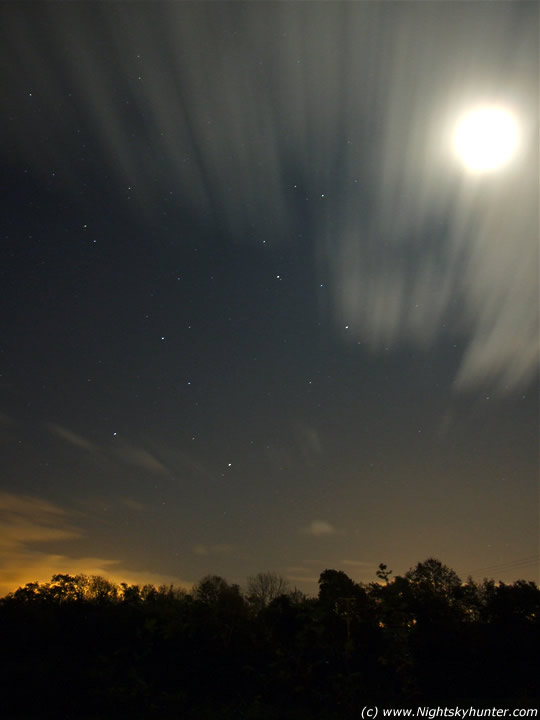 |
05.47. I seen a wonderful mag +2.0 Orionid burn up just below the Pole star. It sported a very long trail and a bulging body. This is looking E just before dawn. Leo dominates the centre of the image. The bright star below is planet Saturn. Above is Leo Minor and one of the paws of the Great Bear. The Moon is in Cancer getting covered by high level cloud from the W which are moving towards the horizon. The cloud thickened and I even seen some mammatus. At 06.00 the sky was overcast so I headed back home. During this session I observed 29 Orionid meteors, 95% of which were brighter than mag +2.0.
Back at home the sky suddenly cleared again so I continued taking more images until it became completely overcast at 06.25. I ended the session at this time. With freezing red hands it took me several attempts to undoe my boot laces because my hands were so numb. It was a good night which I enjoyed very much. Counting both sessions I observed 35 meteors. The highlight for me was the image from earlier in the night. This made it all worth while. I'm still after that elusive fireball capture which has been on my list for a long time. Next up is the northern and southern Taurid meteor shower in November. Until then I wish you clear skies. Thanks for reading.
Martin McKenna